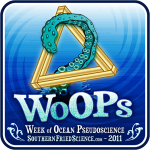
Horseshoe Crabs, Coelacanths, Seven-gilled sharks, hagfish. Throughout the oceans there are creatures whose primitive bodies hearken back to earlier days in our evolutionary history. They possess basal characteristics that are more akin to those of the ancestors of our contemporary phyla. Because we can look into these organisms and learn something about our own deep past, we think of them not as modern descendants, but as living fossils, relics of a primeval state.
This is, of course, a misnomer.
Charles Darwin coined the term living fossil in On the Origin of Species while describing platypuses and lungfish:
In fresh water we find some of the most anomalous forms now known in the world, as the Ornithorhynchus and Lepidosiren, which, like fossils, connect to a certain extent orders now widely separated in the natural scale. These anomalous forms may almost be called living fossils; they have endured to the present day, from having inhabited a confined area, and from having thus been exposed to less severe competition.
The idea of a living fossil implies that the organism has persisted unchanged for hundreds of millions of years and are somehow relics of the ancient past. Despite their apparently primitive (and I use primitive in the phylogenetic sense of the world – possessing basal characteristics), so-called living fossils are modern organisms. They have been shaped by natural selection to adapt to their environment. In some cases, they’ve retained basal phenotypes, while, in many cases, these apparently basal characters are actually derived relatively recently.
Hagfish are a prime example of this. While they possess a relatively primitive body plan, and have a long fossil record that shows that they have changed little in 300 million years, they do not represent a primitive vertebrate form, but are rather are highly divergent from the hagfish/vertebrate common ancestor. While studying modern hagfish could give you insight into the ecology and behavior of ancient hagfish, they will not lead you to startling revelations about the ancestor of vertebrates, at least not directly.
And that’s the problem with branding a modern organism a “living fossil”. We can’t assume that because something looks superficially similar to it’s ancient forms, that it is necessarily unchanged into the present day. Evolution happens on many scales, visible (and fossilize-able) phenotypes are only one scale. While “living fossils” are fascinating examples of how successful characteristics can persist over time, they are not perfect windows into deep past.

Why did you take a picture of horseshoe crabs mating? Perv.
This is a major pet peeve of mine, akin to “highly evolved”, that I hear all the time from scientists. Not only are these phrases conceptually stupid, but they also give creationists something to harp on.
Because one of those horseshoe crabs is really confused.